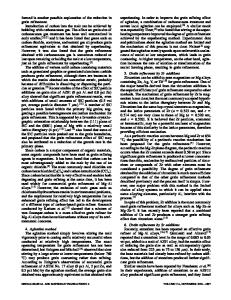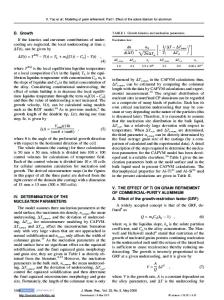Influence of Solute Content and Solidification Parameters on Grain Refinement of Aluminum Weld Metal
- PDF / 937,351 Bytes
- 13 Pages / 593.972 x 792 pts Page_size
- 39 Downloads / 352 Views
vere problem encountered in the welding of certain aluminum alloys is solidification cracking. These cracks may form during solidification of the weld pool, depending on the alloy system and welding conditions. One important parameter that influences the susceptibility to solidification cracking is the weld metal grain structure. It has been shown in several studies that a fine weld metal grain structure can be related to a lower susceptibility to solidification cracking.[1–4] One explanation for this improvement is that the strain is distributed between more grain boundaries.[5] In addition to improving weldability, grain refinement can help in enhancing the mechanical properties of the weld metal such as strength and particularly ductility.[6–9] One way to achieve small weld metal grains is through the addition of grain-refining elements to the filler wire that is fused in the arc welding process and determines the weld metal chemical composition. Some commercial filler wires contain small amounts of elements like e.g., titanium, zirconium, or scandium that are known to help in the refinement of weld metal grain structure.[10] However, it is not well understood how much of these elements is needed to refine the microstructure completely, depending on the chemical composition of the base metal and the welding/solidification parameters. PHILIPP SCHEMPP, Ph.D. Student, ANDREAS PITTNER, Head, and MICHAEL RETHMEIER, Head, are with the BAM, Federal Institute for Materials Research and Testing, Berlin, Germany. Contact e-mail: [email protected] CARL EDWARD CROSS, Staff Scientist, is with the LANL—Los Alamos National Laboratory, Los Alamos, NM. Manuscript submitted September 13, 2012. Article published online February 23, 2013 3198—VOLUME 44A, JULY 2013
One of the most important and most efficient aluminum grain refiners is the master alloy Al Ti5B1 that contains 5 wt pct titanium and 1 wt pct boron.[11] Both elements are present in the master alloy in the form of particles such as Al3Ti[12] and TiB2[13] that act during solidification of the weld pool as heterogeneous solidification nuclei for aluminum grains. The exact role of each particle type is still under discussion; one widely accepted approach suggests that the insoluble TiB2 particles are covered in the liquid aluminum by a thin Al3Ti layer (duplex nucleation theory)[14]—the subsequent peritectic reaction Al3Ti + AlL fi AlS converts them into very efficient solidification nuclei.[12] Properties that make such particles favorable for nucleation of aluminum grains are their size and size distribution,[15,16] shape, and atomic lattice.[17] Hence, sufficient additions of grain refiners like Al Ti5B1 to liquid aluminum can provide a greater number of active solidification nuclei and thus a fine, equiaxed grain structure in the weld metal. Besides the availability of these solidification nuclei, the chemical composition of the weld pool influences strongly nucleation and subsequent grain growth. During equilibrium solidification of a metal, solute redistribution takes place according to the phase dia
Data Loading...











